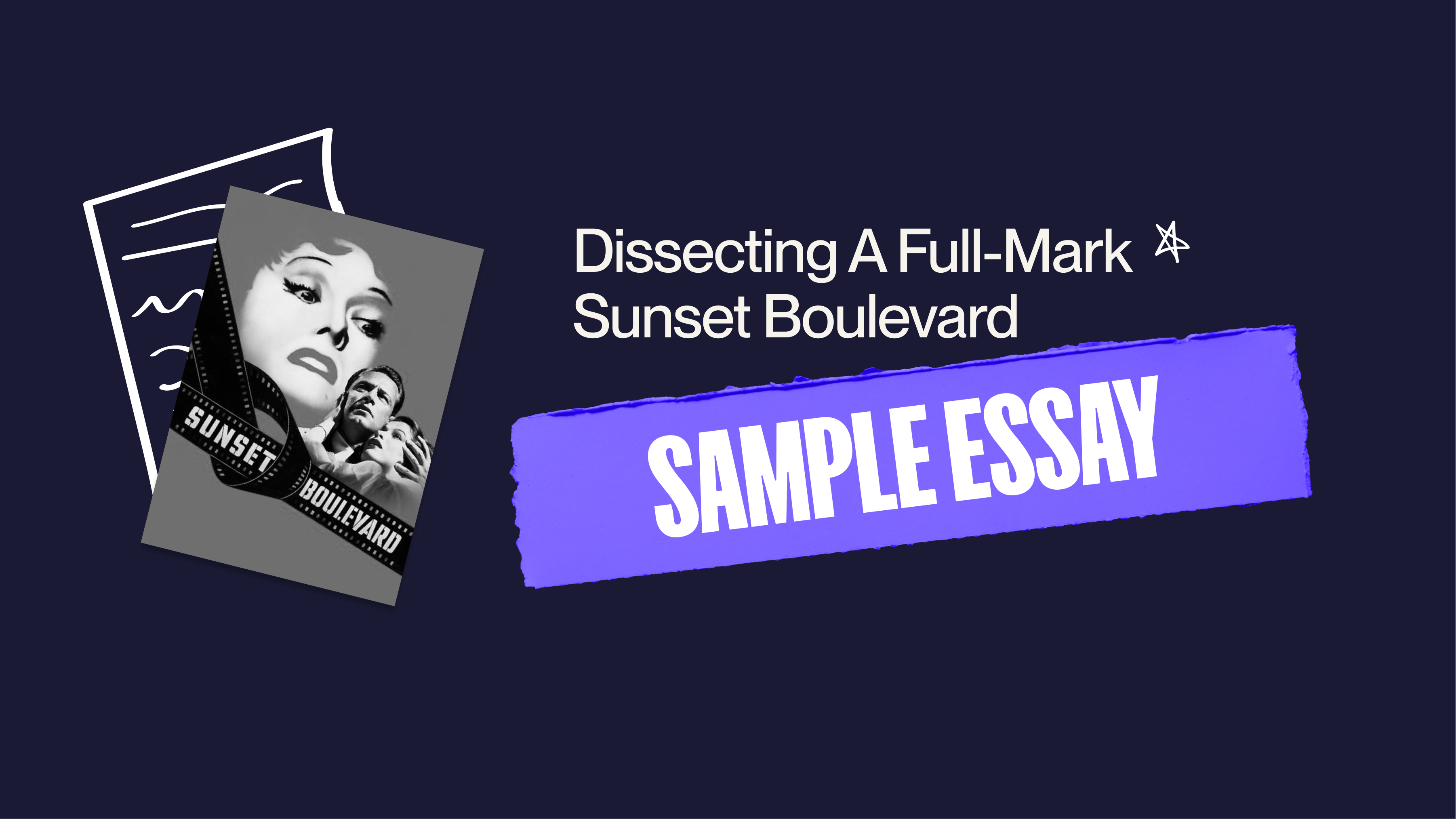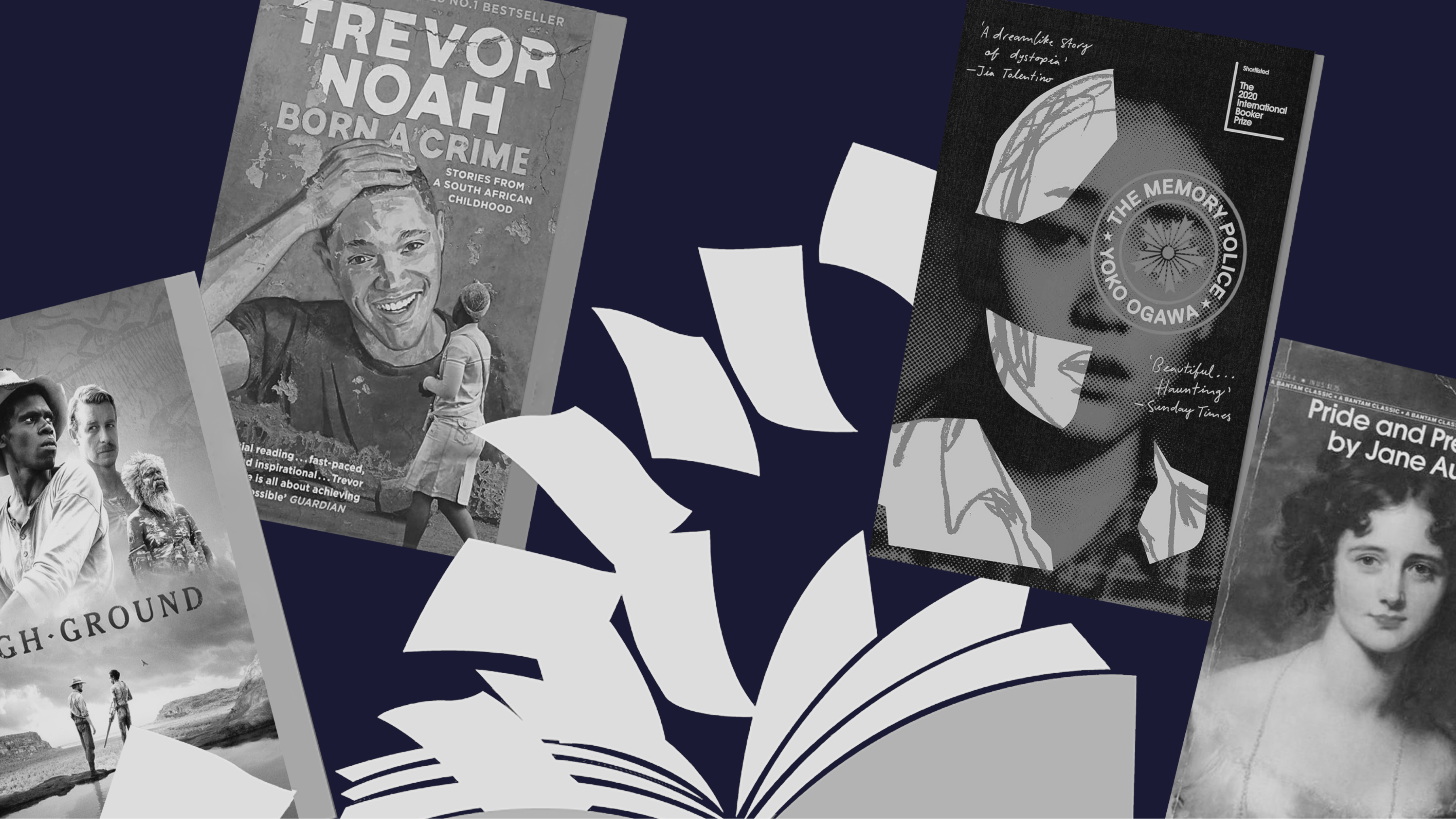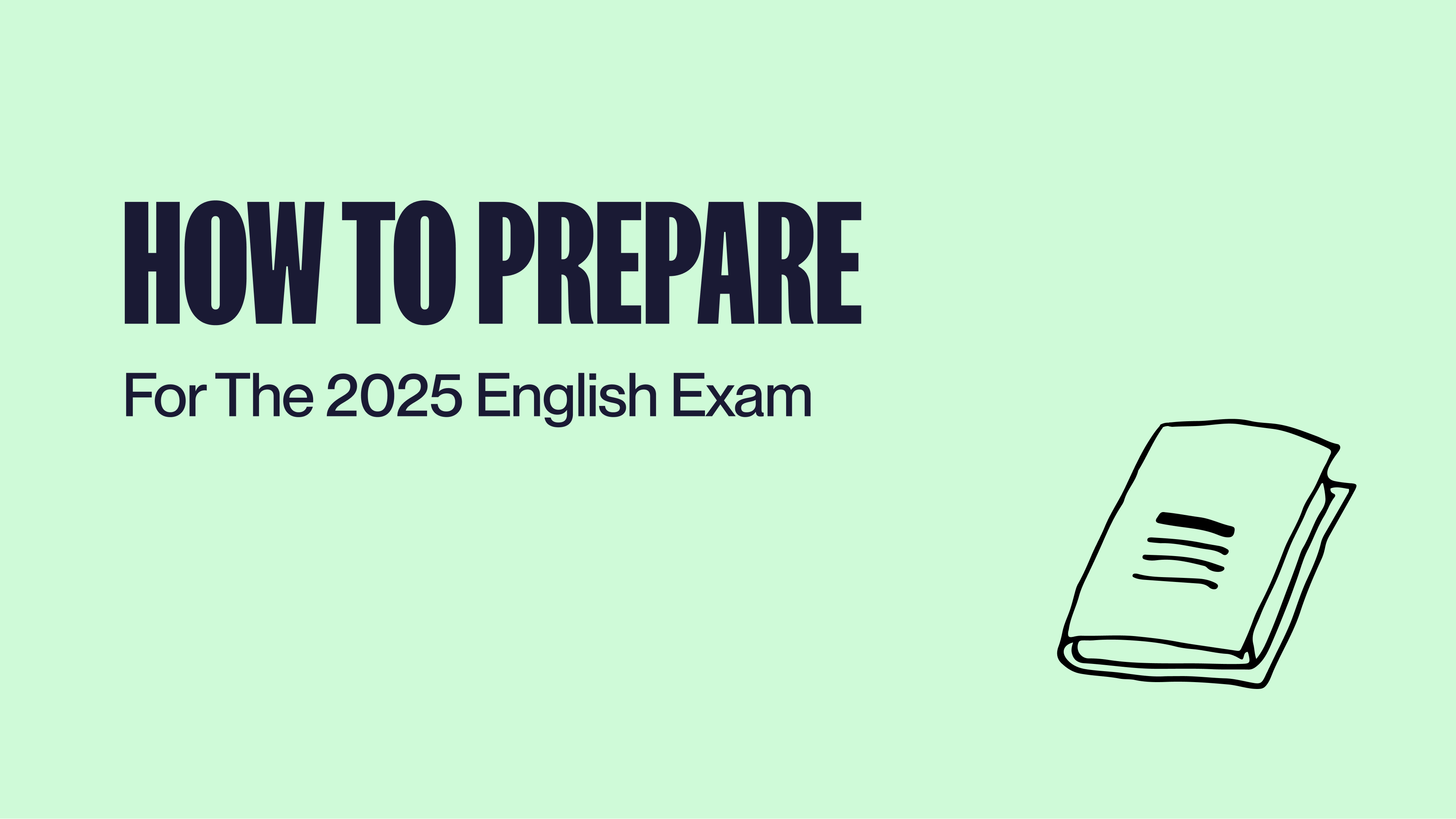
Annotating a Full-mark Sunset Boulevard Essay with a 50 Study Scorer
Written for those who favour examples over general how-to instructions, this blog will dissect a full-mark sample essay on Sunset Boulevard—a “show don’t tell” way of helping you get started with writing your first practice essay. Featured in this blog are detailed annotations breaking down each part of the essay, advice on how to set you apart, as well as the exact elements that will impress assessors.
The prompt:
‘Sunset Boulevard’ reveals the dark side of celebrity and fame. Discuss.
As soon as you see/receive the topic, brainstorm synonyms of the key words to avoid repetition. During the drafting process, make sure you extensively unpack the essay topic. Every word has been chosen to provide an opportunity for analysis, so ensure that you understand its implications and nuances. The ability to properly understand essay topics will separate you from weaker students.
If you are looking for more Sunset Boulevard analysis, check out our Ultimate Guide to Sunset Boulevard here - featuring theme-by-theme analysis as well as a detailed breakdown of the opening sequence.
Based on the key words, I have constructed the following arguments. With the prompt asking us to investigate the “dark side” of celebrity, it is easy to fall into the trap of agreeing with it completely. Across all VCE subjects, “discuss” as a command term has a universal definition:
Present a clear, considered and balanced argument or prose that identifies issues and shows the strengths and weaknesses of, or points for and against, one or more arguments, concepts, factors, hypotheses, narratives and/or opinions.
Therefore, it is important to examine both sides, which is why the third argument addresses optimism rather than Hollywood’s corrupt nature.
1. Personifying this complex world as a dystopian nightmare, Wilder satirically contextualises the hidden horrors of Hollywood.
2. By the catastrophic climax of Wilder’s horrifying creation, it is overwhelmingly transparent that the dark side of fame will ultimately eclipse its idealistic counterpart, as this hope cannot survive unadulterated in the poisonous atmosphere of Hollywood.
3. Challenging his fervent condemnation of Hollywood’s evil, Wilder manufactures a hopeful alternative that appears to exist untarnished by celebrity
Features of a top-scoring essay:
Topic sentence/key ideas: As mentioned above, your essay should not be one-dimensional. Many assessors skim through all of your topic sentences before reading the body paragraphs to ensure that they make sense and address the prompt. If you’ve memorised an essay and simply regurgitated it, markers will be able to tell from reading these alone—you’ll be penalised quite heavily for this so be extra careful.
Explicit and implicit responses to the prompt: Consistent references to the prompt show evidence of engagement with the task. However, it can sound quite repetitive if all mentions of the prompt are explicit (it just isn’t practical). Instead, you can address the prompt in more indirect ways. For instance, with the prompt requiring us to discuss “the dark side of celebrity and fame”, I have addressed the key word through phrases such as:
- hidden horrors of Hollywood
- inevitable tragedy
- burgeoning corruption
- perpetual chase of fame
- fame is too often synonymous with prostitution
- oppression that this pursuit of celebrity has manufactured
- trapped by the noxious allure of Hollywood
- deceptive façade of fame through his pioneering direction
Textual analysis and metalanguage: This is the core “substance” of your essay – it is what separates an A+ from an A, and when done well, it becomes the difference between a 45 and a 50. Our rule of thumb is, never end a sentence without considering how you can “analyse” the text. Essentially, the difference between “analysis” and “summary” lies in, firstly, the semantic focus of your sentence, and secondly, the use of language to convey it (in this case, “metalanguage”). In short, you need to know how to talk about what the author is doing and the language of the text. Examples of this are:
- gothic lens
- noir mystery
- blend of fiction and meta-cinema
- a classic trope of film noir
- amalgamation of fantasy and sobering realism
- eerie posthumous narration of this ‘poor dope’
- non-linear structure
- foreboding non-diegetic string music of Franz Waxman’s pertinent score
Analytical verbs: Lastly, top-scoring essays are specific. The best way to elevate your essay is through a vocabulary makeover. Given the importance of textual analysis, focusing on analytical verbs will most quickly transform your marks. Examples are:
- Personifying
- Immediately referencing
- literally emphasised
- ironically exposes
- thematically foreshadows
- Symbolising
- Functioning as a provocate
- controversially deplores
- Imbued
- embodies
The introduction:
Exposing the powerlessness of naïve ‘dream[s]’ of fulfilment against the toxicity of celebrity which has ‘seized [their] heart[s]’, (1) Billy Wilder’s quintessentially American (2) film ‘Sunset Boulevard’ (1950) poignantly unveils the dark side of fame that is inextricable from Hollywood’s allure (3). Compounded by the skilful overlaying of a gothic lens, this noir mystery (4) performs as a deep meditation on the brutality of this business, and a sardonic, yet subtly sympathetic, depiction of the victims of its endless cycle of sadism (5). Through his intelligent blend of fiction and meta-cinema (6), Wilder’s iconoclastic opus emerges as a powerful vivisection of the dangerous illusions of stardom.
Annotations:
(1) Beginning the piece with an embedded quote adds a degree of complexity and immediately highlights to markers that you have an understanding of the text. It also improves the poetic and sophisticated nature of the text, almost as if it is a literature essay, thus separating your piece from other purely analytical responses.
(2) Recognising the context from the outset also showcases one’s understanding of the wider societal issues and themes.
(3) An immediate reference to the topic is necessary. If the topic isn’t explicitly or implicitly addressed throughout the response, it cannot receive a high mark.
(4) In just a few words, multiple elements of the genre have already been expressed, fortifying the analysis of the film as a whole.
(5) By establishing an equivocating and complex contention, you can prove to markers that you are thinking deeply about the film. Less advanced students will simply explore the ‘dark side of celebrity’, and ignore the opportunity to analyse the silver linings and romantic moments that still exist in the film.
(6) Even in the introduction, metalanguage is woven consistently
(7) The final sentence must return to the topic, but with sophistication.
General introduction tips
Even in the introduction, every word should be selectively chosen to improve and elevate analysis. Be sure to include the director, title and year of release, the context of the era, the genre and conventions (i.e. gothic and noir mystery), as well as the contention.
The importance of introductions cannot be understated. This is particularly significant for the end of year exam, as markers are extremely time-pressured. After reading a few sentences, they will have an idea of the type of student that you are – and the according score – so you want to impress them. Introductions serve as an opportunity to showcase your poetic and literary abilities, as well as your intelligence and sophistication
Body paragraphs:
Personifying this complex world as a dystopian nightmare, Wilder satirically contextualises the hidden horrors of Hollywood (1). Immediately referencing a classic trope of film noir, (2) a disturbing amalgamation of fantasy and sobering realism is established through the eerie posthumous narration of this ‘poor dope’, with this non-linear structure exposing this inevitable tragedy from the outset. Heightening this strange sense of unease, (3) the foreboding non-diegetic string music of Franz Waxman’s pertinent score (4) warns the audience of this ensuing horror. Indeed, ‘Sunset Boulevard’ itself can no longer be hopefully associated with fame and luxury; rather, its disconcerting introduction in a gutter with ‘dead leaves’ and ‘scraps of paper’ alludes to its burgeoning corruption, as literally emphasised by the titular finiteness of ‘sunset’. Ominously towering over this decrepit street, the silhouetted palm trees embody personified judges (5) of the ‘distorted’ and ‘blown out’ stories that ‘Hollywood columnists’ weave, as fortified by the intense chiaroscuro lighting (6). Similarly, (7) although swimming pools were an iconic image of glamour, the floating corpse ironically exposes that this perpetual chase of fame is a deadly enterprise. As a poignant reflection of this danger, the toxic relationship between Joe Gillis – our cynical antihero – and Norma Desmond – the stereotypical antagonist of a femme fatale – (8) is inherently doomed. This Gothic synthesis of old and new Hollywood thematically foreshadows their demise, as both are dangerously delusional: one is confined by their obsolescence, the other ensnared in the shallowness of the present. Symbolising the subordination that defines their affair, the loss of Joe’s car is a ‘matter of life and death’ that resolutely deforms him into an item of Norma’s possession, as fame is too often synonymous with prostitution. Subverting the traditional gender stereotypes of their time, Edith Head’s pertinent costumes of shared leopard print – a predominant motif of Norma’s wardrobe, which is also reminiscent of her silent-era glamour – illuminates the oppression that this pursuit of celebrity has manufactured. (9) In a house with no locks, Joe is already irreparably caught in the predatory grip of Norma’s atrophic talons, and thus, by extension, trapped by the noxious allure of Hollywood. Functioning as a provocateur to brazenly ‘bite the hand that feeds him’ (Mayer) (10) Wilder controversially deplores the deceptive façade of fame through his pioneering direction.
Annotations:
(1) Open with dependent clauses elevates the piece by shifting the pacing. Adverbs are a great opportunity to briefly note tone. Every topic sentence should reference the topic.
(2) Link back to the genre to reflect your wider understanding; most students can only analyse what they see, without considering how this fits into the genre as a whole
(3) It is sophisticated to examine how this makes the audience feel (i.e. unease).
(4) Music is often forgotten in analysis. Films provide opportunities for different types of analysis. Don’t forget the soundtrack/camera angles/acting/outfits.
(5) Develop unique interpretations of symbols. Most students would ignore or neglect the palm trees, simply viewing them as a background item. When you provide unique views and analyses, markers are always impressed.
(6) As mentioned before, having an inventory of metalanguage relating to lighting is greatly sophisticated.
(7) Using linking words like ‘similarly’ underlines to markers that your evidence has been specifically chosen to flow cohesively. Listing dissimilar evidence can weaken the sophistication of your writing
(8) Showing an understanding of character tropes is sophisticated.
(9) Referencing outfits and costume choices can elevate your writing above other pieces, especially when you recognise their purpose as motifs and their significance at the time, such as in relation to gender stereotypes.
(10) The inclusion of one or two external quotes throughout your piece shows a wider contextual understanding and advances your piece to an academic or literary text.
Challenging his fervent condemnation of Hollywood’s evil, Wilder manufactures a hopeful alternative that appears to exist untarnished by celebrity (1). Joe and Betty’s relationship functions as a tender antithesis to the toxically phantasmal alliance of Joe and Norma: this mystery is also an ‘Untitled love story’, saving it from merely being a lurid horror (2). Momentarily, Wilder permits Joe to escape his ‘peculiar prison’ of empty fame, returning to the corporeal world of Artie’s New Year’s gathering, an event imbued with a jollity that is crosscut against the solemn falseness of Norma’s decrepit mansion. From her entrance to the film, Betty Schafer embodies the forgotten passion for truth, ‘itching with ambition’ and presenting a virtuous alternative to Hollywood’s amorality. Illuminating her integrity, Schafer’s intelligence protects her from being deterred by the toxicity that is fundamental to this rapacious industry, as revealed when she is repeatedly misnamed by the sexist producer. Establishing a meta critique of the film industry, Wilder’s script sees this ‘sweet kid’ affirming that ‘pictures should say a little something’ rather than capitalising on being ‘glossy’ and slick’. Pertinently, whilst Norma is a victimised by-product of fame’s lethal illusion, Betty is an astute examiner who ‘know[s] all the plots’, acknowledging and embracing the deception at Hollywood’s core: she likes this ‘cardboard’ and ‘hollow’ town ‘better than any street in the world’. Further emphasising her innocence and purity, Betty’s practical attire of simple skirts and sweaters oppose Norma’s characteristic wardrobe of glamour to highlight the dichotomy between these women. Betty refuses to accept that amorality is inextricable from fame; rather, she empowers to write her own story, both literally and figuratively, reminding us that ‘life can be beautiful’. Hence, she is the perfect counterpart to Joe’s cynicism, embodying both his possible redemption as a man and Hollywood’s rehabilitation as an industry. Her ‘cubby hole’ of an office holds more promise and passion than the entire ‘white elephant’ of Norma’s mansion, highlighting the importance of truth. Their parallel storyline offers an escape for Joe, dislocating him from Norma’s persecution and empowering him to pursue his creative aspirations for motives nobler than shallow renown. Indeed, their witty dialogue – ‘Don’t you sometimes hate yourself?’ – and romantic chemistry symbolise this newfound sense of ambition, concurrently contrasting the sombre superficiality of Norma’s exchanges. Unveiling the wavering silver lining of celebrity, their classic Hollywood kiss offers a reprieve of romance. Emerging as perhaps the most admirable character of this satire, Betty’s genuineness empowers the audience to believe in an industry that prioritises creativity and love over dangerous materialism.
(1) The structure of your essay is ultimately your decision, but having a paragraph that grapples/disagrees with the topic sentence can add an interesting layer of analysis. It provides an opportunity to explore other paths, characters and ideas, and differentiates your work from other responses.
(2) As mentioned previously, it is important to recognise that the film is not one-dimensional: it can be multiple conflicting genres at once.
Notice how this paragraph is based on comparisons and contrasts (e.g. Artie’s party vs Norma’s mansion, and Betty vs Norma). This is far more effective in conveying understanding and nuance than simply analysing characters and settings individually. It is important to consider their wider role and implications within the film.
By the catastrophic climax of Wilder’s horrifying creation, it is overwhelmingly transparent that the dark side of fame will ultimately eclipse its idealistic counterpart, as this hope cannot survive unadulterated in the poisonous atmosphere of Hollywood. (1) Although Joe and Betty’s bond strives to pervert this amorality, even their romance eventually succumbs to the deception of this industry, for they cannot ‘get away with it’. Evidencing the moral dilapidation that is endemic to Hollywood, Betty’s chastity is defiled by the contagiousness of Joe’s shallow illusions; although she ignorantly maintains that she has ‘never heard any of this’, her newfound awareness of the toxicity of celebrity is palpable. As ominously revealed in the opening scenes, our protagonist’s flawed ‘long-term contract’ catalyses his spiritual and physical death, for the amoral motives of fame cannot be without consequence. Foreboded by the dramatic orchestral music, William Holden’s (2) purposeful characterisation of Joe’s premortem trance mirrors the enduring ignorance of Hollywood’s victims. Indeed, his final reach to his briefcase is analogous of the inherent desire of these hopefuls to continue to nourish fame’s deceptive image, even when that fatal bullet has been lodged deep in their unexpecting back. Rather than shattering Norma’s agonising delusions, this murder gruesomely precipitates her resolute descent into madness. Deprived of her moment of anagnorisis, as the role of Salome consumes her, Wilder’s use of mirrors as a motif conveys Norma’s dislocation of real and imaginary. Adorned with royal and theatrical music, Wilder’s staging of Norma’s slow-motion descent of her staircase in her bedazzled dress disturbingly typifies an embodiment of Hollywood’s ghastly underbelly erupting to the surface. With each step on her terminal pursuit of fame, this deranged ghost exits her corporeal sphere, her hyperreality finally becoming inescapable, as ‘there’s nothing else’. Surrounded by spectators yet entirely alone, as the camera closes in on her manic face – with her rigid claws and psychotic eyes blaming the culpable audience – she blurs into this phantasmal purgatory, destroying the alleged integrity of this business. As this ‘dream she had clung to so desperately’ finally ‘enfolded her’, Wilder’s writing expresses that celebrity, or the lack thereof, possesses the omnipotence to corrode a famed icon into an insane killer. Ultimately, ‘Sunset Boulevard’ serves as a dire caution to the horrors of Hollywood, as the ‘price’ of this stardom will always be ‘too high’. (3)
(1) Ensure that, even if your middle paragraph does provide an alternate view, the final paragraph expresses your overarching conclusion. Complexity and equivocation is important, but so is developing strong opinions.
(2) Referencing actors’ names proves that you have done extensive research.
(3) Referencing actors’ names proves that you have done extensive research.
General body paragraph tips:
The topic sentence should not only address the topic and reiterate your contention, but it should also be written in an interesting and sophisticated way to grasp the marker’s interest, and impress them.
Throughout the revision process, it can be helpful to draft and memorise polished and poetic topic sentences that can be used for different themes. Ensure that evidence is cohesive, and that each piece of analysis segues smoothly to avoid a clunky or list-like structure
Notice that neutral verbs like ‘show’ are avoided; rather, most verbs (e.g. subverting/critiquing) have connotations to reflect your analysis.
Every sentence should be driven by analysis too. There is no point in overwriting without purpose; it irritates markers, especially in the final exams
Teachers/markers can tell when you are overwriting and waffling. Avoid long quotes; rather, selectively choose your quotes and embed them effectively.
Don’t neglect the presence of other devices, such as camera angles, outfits and soundtrack. Remember that this is a film; you are not just analysing the words. Keep the genre and conventions in mind, and consider how these impact the presentation of the film. Complex adverb/verb combinations both enhance the sophistication of your writing and provide an opportunity to address the tone and purpose of the director/film.
Have unique interpretations! Students will all be taught the same things -- if you have the capacity to analyse the film yourself, and develop individual analyses, you can ensure that your work will stand out.
Top scoring essays will feature layered devices and analysis – this applies to all texts, and to an extent, argument analysis as well. However, in your own work, make sure that including multiple analyses doesn’t limit cohesion. Similarly with complex vocabulary, ensure that you are not simply searching up synonyms in a thesaurus: it is essential that you actually understand these words and the connotations. In the revision process, make a word bank of sophisticated words that are specific to the film, such as themes and genre
The best way to improve is to write and rewrite body paragraphs. Your essays will improve so much over the course of even a few weeks if you make the effort to constantly reread and edit them. This can be aided by reading it aloud or seeking a second opinion (we can help!). The final piece should be a showcase of your best work, and this can only be achieved if you have been consistent in drafting.
Conclusion
When the blinding lights are finally dimmed and the voyeuristic cameras have long since turned away, the illuminated stars of Hollywood are reduced to incorporeal shadows, hollowed by their loss of recognition, and emptied by unrealised dreams. (1) As ‘Sunset Boulevard’ staunchly conveys, Hollywood is fundamentally a heartless monster, cannibalising its followers to nourish its illusory image. Thus, Norma didn’t truly kill Joe, because Norma Desmond died twenty years ago: rather, he is simply another faceless victim of the crushing mechanisms of celebrity. However, in the consumerist world that Wilder so astutely criticised, there are already thousands of ambitious optimists desperate to fill his vacated place, forever empowering to ‘[kiss the] cold, dead lips’ of this convoluted and disastrous industry. (2)
Annotations:
(1) As with the introduction, the conclusion provides an opportunity to showcase your linguistic and literary abilities with a poetic and poignant finale
(2) Sometimes, the conclusion can elevate a piece from a 9 to a 10. Try and brainstorm final sentences/ideas that stay in the marker’s mind. You want to leave a strong and lasting impression of your talent and complexity.
General conclusion tips:
You’re likely to be quite tired at the end of the hour after focusing so much on “grinding out” ideas. However, if time allows, use this to your advantage. Most students will just reiterate their main points, but it is actually an opportunity to divert from more rigid essay structures and exhibit your English talents. Make sure your contention is still strong – but tweak it to show your understanding of the text’s views and values.



